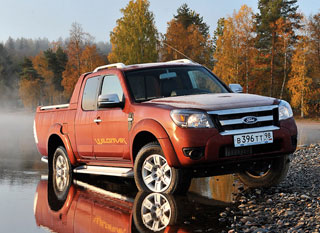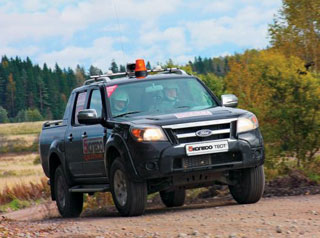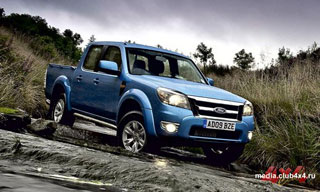Test drive Ford Ranger 1992 - 2010 compartment
Pokemon and baseball cap
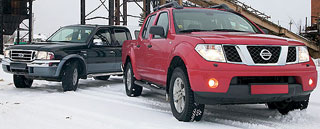 All America has long and firmly obsessed with pickups. They carry cans of milk with milk, which gives a cow from the state, bricks, boards, skis, snowmobiles, bicycles, tents - anything. These are cars for all occasions. American life. Partly - Japanese. But for some reason not yet Russian. Pickup is one of the most underestimated four -wheeled vehicles in Russia. However, there is a suspicion that we have his time on the way. They are about to appreciate. For example, we have already appreciated.
All America has long and firmly obsessed with pickups. They carry cans of milk with milk, which gives a cow from the state, bricks, boards, skis, snowmobiles, bicycles, tents - anything. These are cars for all occasions. American life. Partly - Japanese. But for some reason not yet Russian. Pickup is one of the most underestimated four -wheeled vehicles in Russia. However, there is a suspicion that we have his time on the way. They are about to appreciate. For example, we have already appreciated. 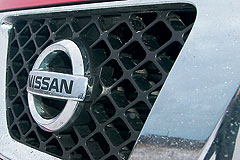 Close the back of the pickup with your palm in the photo - you will see a car that is in no way inferior to a good SUV. Now close the front and count. The cost of a piece of the frame and the trough of the trough on it is a few interest on the cost of the entire car - hence the relatively humane price of the car. But is it all the same, what to carry the air - in an open body or in the salon? In the latter case, there are even minuses: the air must be heated or cooled, which is spent by the time and gasoline. In a single cabin of a real pickup, this is much easier. However, they do not understand with us, and in Europe such cars. Only modifications with a five-seater double cabin are in demand (and in the States such pickups are actually considered underdeveloped cargo). It is on the tastes of the Old World that the latest Nissan Navara, which replaced the discrepancy, like a mouse, Nissan Pickup, is oriented. We will compare it with Ford Ranger-a light track that is released relatively long ago.
Close the back of the pickup with your palm in the photo - you will see a car that is in no way inferior to a good SUV. Now close the front and count. The cost of a piece of the frame and the trough of the trough on it is a few interest on the cost of the entire car - hence the relatively humane price of the car. But is it all the same, what to carry the air - in an open body or in the salon? In the latter case, there are even minuses: the air must be heated or cooled, which is spent by the time and gasoline. In a single cabin of a real pickup, this is much easier. However, they do not understand with us, and in Europe such cars. Only modifications with a five-seater double cabin are in demand (and in the States such pickups are actually considered underdeveloped cargo). It is on the tastes of the Old World that the latest Nissan Navara, which replaced the discrepancy, like a mouse, Nissan Pickup, is oriented. We will compare it with Ford Ranger-a light track that is released relatively long ago. 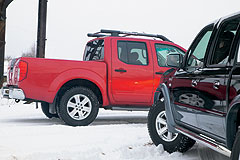 Pick Me Up. Ford looks in front as a classic SUV, shines with chrome, remembered by two -tone coloring. On the lower edge of the body and back it is encircled by protective arcs, and this solution looks reasonable - they do not stick out to limit cross -country ability, and at the same time protect the sides. A white hard kung, standing on a test machine, is also very practical, although it locks with frail locks and gives Ranger a slightly funny look.
Pick Me Up. Ford looks in front as a classic SUV, shines with chrome, remembered by two -tone coloring. On the lower edge of the body and back it is encircled by protective arcs, and this solution looks reasonable - they do not stick out to limit cross -country ability, and at the same time protect the sides. A white hard kung, standing on a test machine, is also very practical, although it locks with frail locks and gives Ranger a slightly funny look. Navara due to convex wheeled arches, roots on the roof and chamfers around the side windows in the spirit, well, why not Hummer? It looks much more warlike, but in fact, judging only by appearance, it is less adapted for vagrancy by off -road. In front - painfully a passenger bumper. A large bandwagon is convenient for planting, but hangs under the belly enough so that the soil was struck on steep tubercles. And behind the bottom of the body is practically nothing but mudguards. Nissan is wider than 4 cm longer and longer. And although the Ford light has only 208 versus 233 mm in Ford (the lower point is the crossbar of the frame on which the checkpoint is fixed), it is this machine that can be pushed through those obstacles that will stop Navara.
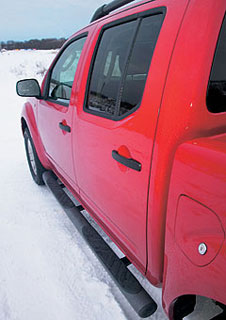 Navara, exuding the fashionable spirit of high-tech, will fit well into the garage of an extreme lover, in which surfing, snowmobile, and a herd of bicycles are already dusting. The owner of Navara will immediately go on a brand new machine to purchase equipment for another adrenaline mania. And old Ranger, and even with kung, is unlikely to see a heated garage in his life. In the afternoon, he will plow like a gazelle, at night - to pretend to be a jeep, and on weekends - to carry the relatives of the owner to the nature of.
Navara, exuding the fashionable spirit of high-tech, will fit well into the garage of an extreme lover, in which surfing, snowmobile, and a herd of bicycles are already dusting. The owner of Navara will immediately go on a brand new machine to purchase equipment for another adrenaline mania. And old Ranger, and even with kung, is unlikely to see a heated garage in his life. In the afternoon, he will plow like a gazelle, at night - to pretend to be a jeep, and on weekends - to carry the relatives of the owner to the nature of. Of course, they can change roles. There is Navara for the case - SE, with a pen, without skin and other excesses. There is an exclusive Ranger Wildtrack for dardry - it differs mainly to the decoration. But it is difficult to imagine the substitution: the Japanese hard worker will not be cheap enough, and a stylish savage - cheap suspicious.
Squares and volumes are slightly different: in Ranger - 1530 by 1536 mm (in the width of the wheel arches - 1090 mm), in Navara it is shorter and wider - 1511 by 1560 mm (in arches - 1130). The height of the sides is 405 and 475 mm, respectively. At first glance, Navara gives more advantages, which, incidentally, in the body is located much more advanced than banal eyes, the C-channel cargo attachment system. However, the American pickup can take more than a ton of cargo on board, and the Japanese - only 765 kilos plus a hundred for rails. And the navara -littered inside the side actually slightly limits the dimensions of the cargo transported. The advantages of both of the car should be attributed
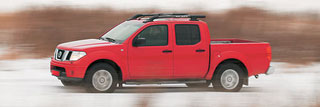 strong and easily thrown back board. To the disadvantages - the lack of a protective coating of both the body itself and its upper edges. And a little about prices. The branded plastic pallet for Ranger can be ordered for $ 696, and for Navara - for $ 336. A removable kung and a native canor for the first will cost $ 2364 and $ 708, and for the second - $ 2337 and $ 289 plus $ 87.65 per wiring.
strong and easily thrown back board. To the disadvantages - the lack of a protective coating of both the body itself and its upper edges. And a little about prices. The branded plastic pallet for Ranger can be ordered for $ 696, and for Navara - for $ 336. A removable kung and a native canor for the first will cost $ 2364 and $ 708, and for the second - $ 2337 and $ 289 plus $ 87.65 per wiring. The Japanese novelty leaves no chance of a competitor for comfort and equipment. There are much more places on the rear laid seats in Navara. There are niches for small things under the seat. Finally, the interior looks more modern. Navara in the LE configuration also has a luxurious leather interior (for Ranger - option, $ 1596).
Both cars have a strong frame chassis, spring -off rear axle suspension and an independent front wheel suspension. The wheel formula is also the same. In ordinary road traffic, cars are driven by rear wheels, and 4WD mode is forcibly: Ford - a small lever of the handout, which is adjacent to the lever of the checkpoint, Nissan with an electronic system with a rotating selector on the console. Both in the Japanese and American car, a reduced series of LO programs is provided. But there are features. Navara additionally has a rear differential lock (acts at speeds up to 40 km/h). Ranger - the function of automatic connection of the front axis wheels, which R.F.W. On the dashboard. You can get the car out of this mode with a simple click of the button.
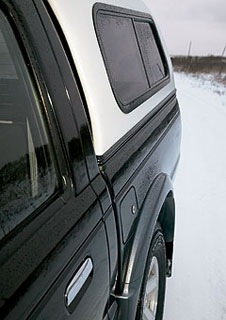 They participate in the race. The driver's seat in Ford has a very modest set of mechanical adjustments. The Navara chair with eight settings is much more convenient. The steering column in both machines is regulated only in height. If you also need a longitudinal rudder adjustment, then you are sitting wrong, ”the Americans say and the Japanese consonant with them. Maybe they are right.
They participate in the race. The driver's seat in Ford has a very modest set of mechanical adjustments. The Navara chair with eight settings is much more convenient. The steering column in both machines is regulated only in height. If you also need a longitudinal rudder adjustment, then you are sitting wrong, ”the Americans say and the Japanese consonant with them. Maybe they are right. The turbodiesel of the American light tree transmits more vibrations to the body at idle (even the handles of the transmission are shaking from them), but there are no more no more noise from it than in the Japanese competitor. A good Ranger dynamics is explained by the mechanical transmission with a high gear ratio of the main pair-the car does not want to go faster than 140 km/h, but it is much more vigorous in any transmission than could be expected from a 109-horsepower engine. The machine, which is in Navara, on the contrary, conceals the high traction capabilities of the advanced 174-horsepower turbodiesel, and the dynamics also worsen due to a larger, almost 400 kilos, masses. As a result, the acceleration is some kind of limousine-the car does not react to the accelerator right away, the speed is gathering softly, spring. If Ranger starts with a synchronously, then from the Navara cabin he will look like a horse that rushed immediately into a gallop from fright.
The suspension of the Japanese car works more comfortably - it reacts less to small irregularities, and more collectively practices large ones. Ranger sways harder, may go crash when he rides empty.
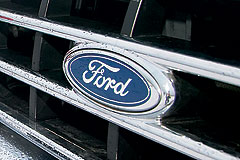 However, all these remarks are off -road. On the Navara highway, as they say, it just rolls, and Ford gives something more - it has a more transparent steering. Nissan can maintain both high cruising speed and a torn ride style. Ranger is simply not capable of the first, and frequent strong brakes do something bad with the brakes (temporarily).
However, all these remarks are off -road. On the Navara highway, as they say, it just rolls, and Ford gives something more - it has a more transparent steering. Nissan can maintain both high cruising speed and a torn ride style. Ranger is simply not capable of the first, and frequent strong brakes do something bad with the brakes (temporarily). When driving in bad weather, Navara pleases with a well -tuned rain sensor and clean mirrors (in Ranger they and the side windows get dirty quite quickly). However, the competitor is noticeably more economical in the city and more maneuverable (for a U -turn, Navara needs almost 14 meters from wall to wall).
10 YEARS LATER. The actual differences in equipment are quite consistent with the ten thousandth difference in the price of cars. Nevertheless, Ranger has a price, much more correct for pickupa. And this will be determined not only by the person of the buyer, but also, let's say, the career of the car. Ranger will be bought for economic business, they will intensively use it on this case and put it to a pension oh how soon: even ten years later he, who has lost the gloss, will serve as a workhorse. Navara will initially be purchased for sports and picnic-wrestling fun. And if he does not die from the strangle and wounds, transporting moose carcasses, nets and boat engines to the deaf thickets, then by his decade it will be sold almost for a nothing to be a successful farmer who will not spare either the interior of the business class, or the body will increase the side and will increase the side and Lucky chickens on the market. All pickups are generally one fate, only the terms are different ...
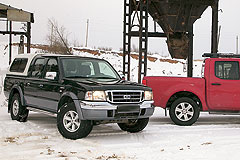 Where is the soap dish? With amenities in Navara, full order. The driver's seat has a lot of electrical adjustments. The passenger is also not offended, although his seat has half as much settings - only four. The pen on the front rack will help you put your fifth point into the interior and only then - your legs, having previously shook them off. In the console there is music without a colored LCD display, however, such an audio system (by the way, with a chainer) looks and does not sound poor.
Where is the soap dish? With amenities in Navara, full order. The driver's seat has a lot of electrical adjustments. The passenger is also not offended, although his seat has half as much settings - only four. The pen on the front rack will help you put your fifth point into the interior and only then - your legs, having previously shook them off. In the console there is music without a colored LCD display, however, such an audio system (by the way, with a chainer) looks and does not sound poor. Holding switches and especially the buttons on the steering wheel are made correctly. You come to this conclusion when you transplant into another car and feel that there is no something you need under your thumbs now. Climate control has separate adjustment. The developers with that part of the dashboard, which below the steering wheel, overdid it - the knees of the driver’s tall will probably come into contact with soft plastic.
The rest of the Navara salon can serve as a model for many cars, including a business class: not every car for $ 40,000 has an interior where aesthetics, ergonomics and the quality of materials are so well combined. An unpleasant surprise can be presented later, when it will be pretty lit, and it will not be possible to return the original appearance.
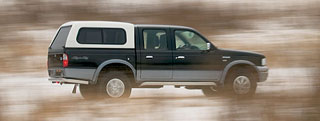 Where are the cup holders? If the Ford pickup appearance is not in doubt about its origin, then in the interior of American style it is not visible at all. The notorious cup holders are only two recesses at the checkpoint handle. You can probably put a tall liter glass of cola here, but it is worth sticking the first gear, and dishes will lose the contents. Well, Ranger was created with an eye on the Mazda pickup, so he picked up his interior, so typical of the Japanese cars of the last century. It is better not to peer into his details: the unit with the inscription Climate Control is actually a condo air conditioner, and with an insufficiently powerful blow; White devices are poorly read when the backlight is turned on during the day, and the console and the sloppy covers of levers, divided into three steps, quickly collect dirt. You find pluses in the Ranger salon when you act without looking. You easily find each button and pen to the touch. The long and tight (but well -tangible) stroke of the mixing can irritate with sluggish urban driving, but on the off -road, with a wild risk and the need for power management, the risk of mistaken with the choice of transmission is minimized.
Where are the cup holders? If the Ford pickup appearance is not in doubt about its origin, then in the interior of American style it is not visible at all. The notorious cup holders are only two recesses at the checkpoint handle. You can probably put a tall liter glass of cola here, but it is worth sticking the first gear, and dishes will lose the contents. Well, Ranger was created with an eye on the Mazda pickup, so he picked up his interior, so typical of the Japanese cars of the last century. It is better not to peer into his details: the unit with the inscription Climate Control is actually a condo air conditioner, and with an insufficiently powerful blow; White devices are poorly read when the backlight is turned on during the day, and the console and the sloppy covers of levers, divided into three steps, quickly collect dirt. You find pluses in the Ranger salon when you act without looking. You easily find each button and pen to the touch. The long and tight (but well -tangible) stroke of the mixing can irritate with sluggish urban driving, but on the off -road, with a wild risk and the need for power management, the risk of mistaken with the choice of transmission is minimized. Text Ruslan Tarasov, photo Andrey Danilov
We thank for help in organizing the shooting of CJSC Ford Motor Company, (495) 777-8500, Nisan Motor Rus LLC, (495) 961-2131.
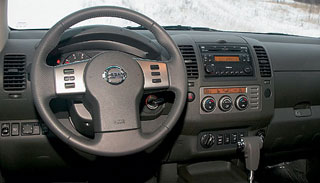 Nissan Navara 2.5 LE
Nissan Navara 2.5 LE Turbodiesel engine, 4 in a row
Working volume (cubic cub) 2488
Power (L.S. at rpm) 174 at 4000
Moment (nm at rpm) 403 at 2000
Rear drive, connected full
Gearbox 5-speed, automatic
Length/width/height (mm) 5220/1850/1780
Equipped mass (kg) 2045
Maximum speed (km/h) 170
Acceleration to 100 km/h (c) 11.5
Fuel consumption (city/highway, l/100 km) 11.7/7.8
Price in Moscow (price of the tested car) from $ 42,690 ($ 42,690)
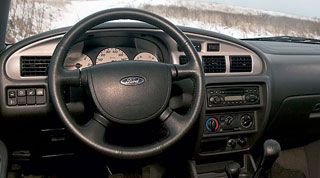 Ford Ranger 2.5 XLT
Ford Ranger 2.5 XLT Turbodiesel engine, 4 in a row
Working volume (cubic cub) 2499
Power (L.S. at rpm) 109 at 3500
Moment (nm at rpm) 266 at 2000
Rear drive, connected full
Gearbox 5-speed, mechanical, with reduced nearby
Length/width/height (mm) 5088/1810/1760
Mass weight (kg) 1710
Maximum speed (km/h) n/d
Acceleration to 100 km/h (c) n/d
Fuel consumption (city/highway, l/100 km) n/d
Price in Moscow (price of the tested car) from $ 27,600 ($ 30 660)
Source: "Autopilot"

